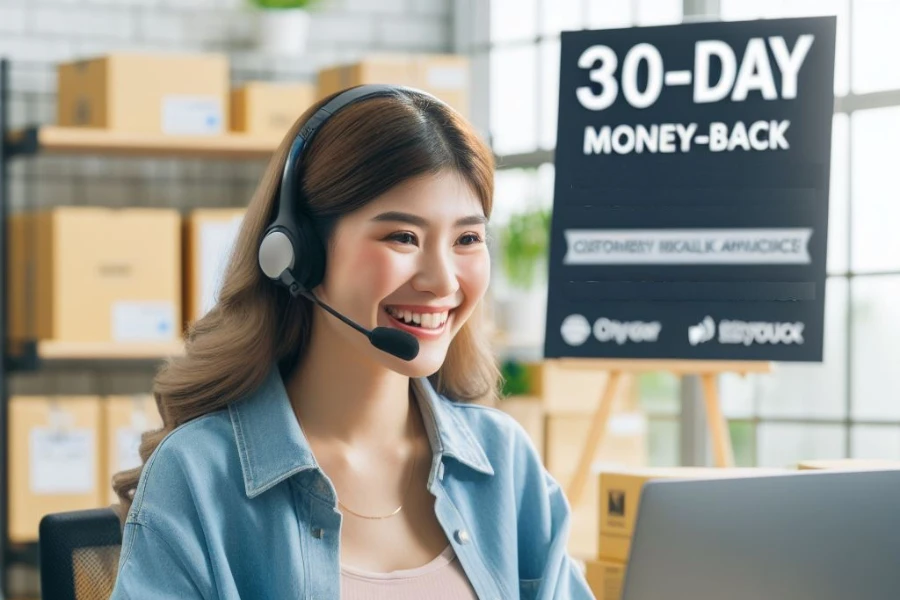Key takeaways
- In reverse logistics, customer experience is an important factor that businesses cannot afford to ignore.
- Prioritizing a simple and easy return procedure gives businesses the chance to increase customer happiness, cultivate loyalty, and establish trust.
- Reverse logistics success may be fueled by implementing user-friendly return procedures, using technology to expedite operations, communicating clearly, and customizing the customer experience.
- Businesses may increase revenue and establish the foundation for sustained development and success in the cutthroat industry by concentrating on giving consumers an enjoyable and unforgettable experience.
- It is clear that customer experience in reverse logistics is more than simply a procedure; rather, it represents a strategic chance to establish enduring bonds with clients and propel corporate expansion.

Introduction
As a seasoned blogger, I am aware of how important customer experience is to reverse logistics. It’s important to develop client loyalty and trust in addition to handling returns effectively. Businesses may provide clients a great and unforgettable experience by emphasizing clear communication, individualized interactions, and easy-to-use return procedures. Customer satisfaction may be increased and the return experience generally improved by putting cutting-edge technologies like self-service return kiosks and automated return labels into practice. Technology is also essential for optimizing processes and ensuring transparency all the way through the return process. Building lasting connections and increasing consumer loyalty requires clear communication and tailored interactions. Prioritizing customer experience in reverse logistics is more than simply a procedure in this cutthroat industry; it’s a calculated chance for strategic advantage.
Understanding the importance of customer experience in reverse logistics
client experience is a key factor in fostering client loyalty and satisfaction in the reverse logistics industry. The procedures involved in managing product returns, repairs, and replacements are referred to as reverse logistics. Even while the forward logistics of shipping goods to clients receive most of the attention, the reverse logistics procedure is just as crucial. Comprehending the significance of customer experience in reverse logistics and its potential to affect a firm’s financial performance is crucial.
In reverse logistics, providing a great customer experience involves more than just handling returns quickly; it also entails building a solid rapport of dependability and trust with clients. Businesses who put the customer experience first and improve it in reverse logistics are basically making an investment in their customers’ long-term relationships. Giving consumers a simple and easy return procedure makes them feel valued and appreciated, which increases customer satisfaction and loyalty.
Positive return experiences increase a customer’s likelihood of forming repeat purchases and trusting the company. The cornerstone of this trust is a simple and open return policy that gives consumers confidence. Conversely, a bad encounter can seriously harm a customer’s confidence and contentment. Dissatisfaction and frustration from a complicated or poorly managed return process can result in customers seeking alternatives and potentially turning away from the brand.
As a result, businesses must give the customer experience first priority when it comes to reverse logistics. Businesses may make a good impression on customers by providing easy-to-use return procedures, transparent communication, and tailored interactions. In addition to increasing happiness and loyalty, this creates the conditions for long-term success and expansion in the cutthroat industry. In summary, customer experience in reverse logistics is more than simply a procedure; it’s a strategic chance to create enduring bonds with clients and propel company growth.
Implementing user-friendly return processes
Businesses may go above and above by offering user-friendly return procedures in order to further improve the client experience in reverse logistics. This might entail making sure that every stage of the return process is smoothly integrated in addition to providing a variety of channels for customers to initiate returns, such as an online portal, mobile app, or customer care hotline. The client should be able to easily understand the entire procedure by receiving clear and unambiguous instructions on how to package the item for return and how to ship it back to the firm.
To further simplify the return procedure, businesses could think about using cutting-edge technologies like automatic return labels or QR codes. Businesses may lessen consumer effort and annoyance by using technology to streamline the return process, which will eventually result in a more pleasant and fulfilling experience for the customer. Customers are more likely to feel secure and at ease participating in reverse logistics when these user-friendly return procedures are in place, which promotes greater brand satisfaction and loyalty.
Additionally, businesses may want to think about partnering with third-party providers or key retail locations to establish a self-service return kiosk option. Customers may quickly drop off their returns at designated kiosks thanks to this innovative technique, which offers a quick and hassle-free alternative for individuals who would rather not bother with packaging and shipping. Businesses may accommodate a range of consumer preferences and improve the return experience by providing a range of return choices, such as drop-off sites, pick-up services, prepaid mailing labels, and self-service kiosks. In addition to increasing consumer happiness, this degree of ease and flexibility lays the groundwork for fostering enduring brand loyalty and trust.
Utilizing technology to streamline reverse logistics operations
Technology is essential for improving customer satisfaction and optimizing reverse logistics operations. Businesses may maintain inventory, handle refunds and replacements, and handle returns with efficiency by utilizing automation tools and sophisticated software systems. Businesses may lower manual mistake rates, increase operational effectiveness, and give consumers speedier service by putting these technologies into practice.
Technology also makes it possible for businesses to get insightful information and useful data from the reverse logistics process. Businesses can find trends, patterns, and opportunities for improvement in their return procedures by examining this data. By using a data-driven strategy, businesses can optimize their reverse logistics operations and provide a more seamless and gratifying client experience by making well-informed decisions.
Technology can also help with efficient consumer communication throughout the return process. At important touchpoints, consumers may receive automated updates and notifications that keep them informed and involved. In addition to lowering customers’ doubts and anxieties, this proactive communication demonstrates the business’s dedication to openness and client happiness.
All things considered, the use of technology in reverse logistics improves customer satisfaction while streamlining processes. Enterprises may enhance customer satisfaction and loyalty by implementing a more streamlined, transparent, and customized return procedure through the utilization of sophisticated software systems, automation tools, and data analytics.
Technology can also provide transparency and real-time visibility throughout the return process. Consumers may get progress updates on their returns, such as when they’ve been received, processed, and given a refund or replacement. Customers are reassured by this degree of openness, which also shows the company’s dedication to giving them a satisfying reverse logistics experience.

Providing clear communication and transparency throughout the return process
The key to a smooth and effective return procedure for clients is clear communication. It is essential for businesses to give customers precise information on how to start a return, package the item for shipping, and return it to the business. Furthermore, in order to guarantee that consumers are fully informed and prevent any surprises, it is imperative that the return policy be communicated in a straightforward manner, including information on any associated costs or restocking charges.
Companies may establish credibility and trust with their consumers by communicating honestly and openly with them over the full return process. This proactive approach not only shows a company’s dedication to offering a pleasant customer experience in reverse logistics, but it also helps to allay any doubts or fears that customers may have.
Essentially, building a relationship of trust and dependability with clients is the goal of transparent communication, which goes beyond simply communicating facts. Businesses may enhance customer happiness, boost loyalty, and ultimately propel long-term success in their commercial activities by placing a high priority on honest communication throughout the return process.
Companies should communicate with customers in an honest and open manner during the return process. This entails swiftly responding to any questions or concerns from customers and provide frequent updates on the return’s progress. Even during the reverse logistics process, businesses may foster customer loyalty and trust by providing them with information and engagement.
Personalizing the customer experience to drive loyalty
In reverse logistics, personalization is essential for fostering client loyalty. Businesses may use client information and preferences to customize the return experience for each unique consumer. This might be customized return policies, suggestions for related goods, or exclusive deals to encourage further purchases.
Businesses may create a memorable and unique customer experience that extends beyond a transaction by tailoring the customer experience to each individual consumer. This customized strategy builds a deep emotional bond between the customer and the brand in addition to fostering loyalty and satisfaction. Businesses may demonstrate their dedication to delivering great customer service and creating enduring connections by learning about and meeting the unique demands and preferences of each individual client.
Moreover, as consumers are more likely to return for additional purchases and refer the brand to others, individualized interactions in reverse logistics can raise the customer lifetime value. In a competitive market, businesses may distinguish out from the competition by going above and beyond to customize the return experience. This kind of personalized attention and care builds good word-of-mouth referrals and client loyalty, which in turn propels business expansion and success.
Conclusion
In conclusion, businesses hoping to create enduring bonds and foster commercial success must prioritize the client experience in reverse logistics. Through the implementation of user-friendly return procedures, the utilization of technology to expedite operations, unambiguous communication, and customization of the client experience, businesses may establish a favorable and noteworthy engagement that promotes retention and contentment. Customers are more likely to trust and believe in businesses that are transparent and have clear communication throughout the return process, and individualized interactions demonstrate a dedication to providing excellent service. Ultimately, businesses may stand out from the competition, encourage client loyalty, and lay the groundwork for sustained success in a cutthroat industry by emphasizing on the customer experience in reverse logistics.

FAQ
What is the role of reverse logistics in enhancing customer satisfaction and loyalty?
Because reverse logistics makes it easy and convenient for customers to return items, it greatly contributes to increased customer satisfaction and loyalty. Companies can lessen customer effort and frustration by providing a variety of channels for starting returns, precise instructions on packaging and shipping items, and creative solutions like automated return labels or self-service kiosks. All of these measures will ultimately result in a more positive experience for customers. Throughout the return process, using technology to collect useful data, interact with consumers efficiently, and expedite processes all contributes to improving the entire customer experience. Transparent communication and customized interactions based on the preferences of each individual client may also boost customer lifetime value, foster loyalty, and set businesses apart from rivals in a competitive market. Prioritizing the client experience in reverse logistics allows businesses to create enduring relationships and foster trust and satisfaction, ultimately driving business growth and success.
What is customer experience in logistics?
The term “customer experience” in logistics describes the general interactions and level of pleasure that consumers have when they receive, use, and return goods or services. It includes all customer interactions, starting from the time they make an order and ending when they choose to return anything. In logistics, smooth transactions, lucid communication, tailored encounters, and effective issue resolution are all essential for a satisfying customer experience. By placing a high priority on the customer experience in logistics, businesses can foster a culture of trust, loyalty, and happiness that will eventually lead to long-term success and expansion.
How does logistics help in improving customer satisfaction?
Because logistics makes sure that goods are delivered precisely, on schedule, and in good condition, it plays a critical role in raising customer satisfaction. Errors and delays may be avoided, and the entire customer experience can be improved, with an orderly and effective logistics operation. Companies may satisfy consumer expectations and improve their logistics operations by establishing efficient inventory management methods, using cutting-edge tracking technologies, and optimizing transportation routes.
Additionally, logistics is essential to the reverse logistics process, which handles swaps and returns. Effective logistics operations that enable a smooth and trouble-free return procedure may have a big influence on customer satisfaction. Companies may foster customer loyalty and trust by offering simple return policies, regular information on the status of returns, and clear instructions.
Essentially, the foundation of every effective customer experience strategy is logistics. Companies can guarantee that items reach clients on time, that returns are handled properly, and that overall customer happiness is maximized by concentrating on efficient and effective logistics procedures. Businesses may provide consumers with an enjoyable and memorable experience by putting logistics first in their operations. This will eventually boost customer loyalty and promote long-term success.
What are the 5 R’s of reverse logistics?
Companies must adhere to the 5 R’s of reverse logistics as a fundamental foundation to efficiently handle the return process and foster client loyalty and pleasure. Among these five Rs are:
1. Returns: Managing client returns is the first stage in the reverse logistics process. TThisentails giving precise directions on how to start a return, packing the item for delivery, and returning it to the business.
2. Remanufacturing: Following a return, businesses might determine if an item can be reconditioned or remanufactured for future sale. Returned goods must be restored, cleaned, or updated in this phase to make sure they are in like-new condition.
3. resale: Businesses may choose to resale products through secondary markets or liquidation channels if they are unable to be remanufactured. This helps to recoup some of the costs associated with returns and reduces waste.
4. Recycling: Businesses can recycle items to recover important materials and lessen their environmental effect when they can’t be resold or rebuilt. Recycling in reverse logistics contributes to sustainability and waste reduction.
5. Recovery: Recovering value from returned goods by recycling, remanufacturing, or resale is the last phase in the five Rs of reverse logistics. Through the optimization of value recovery from returned products, businesses may enhance their reverse logistics processes and achieve sustained prosperity.
By following the 5 R’s of reverse logistics, companies can streamline their return processes, reduce costs, and enhance customer satisfaction and loyalty. This framework provides a comprehensive approach to managing returns and maximizing the value of returned products, ultimately contributing to a positive customer experience in reverse logistics.
Hope this article was helpful for more check out previous blog post by clicking here


